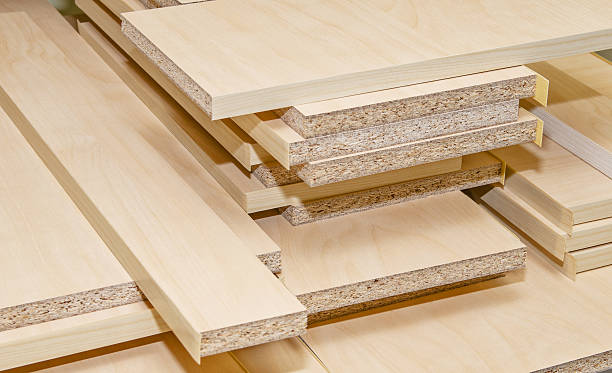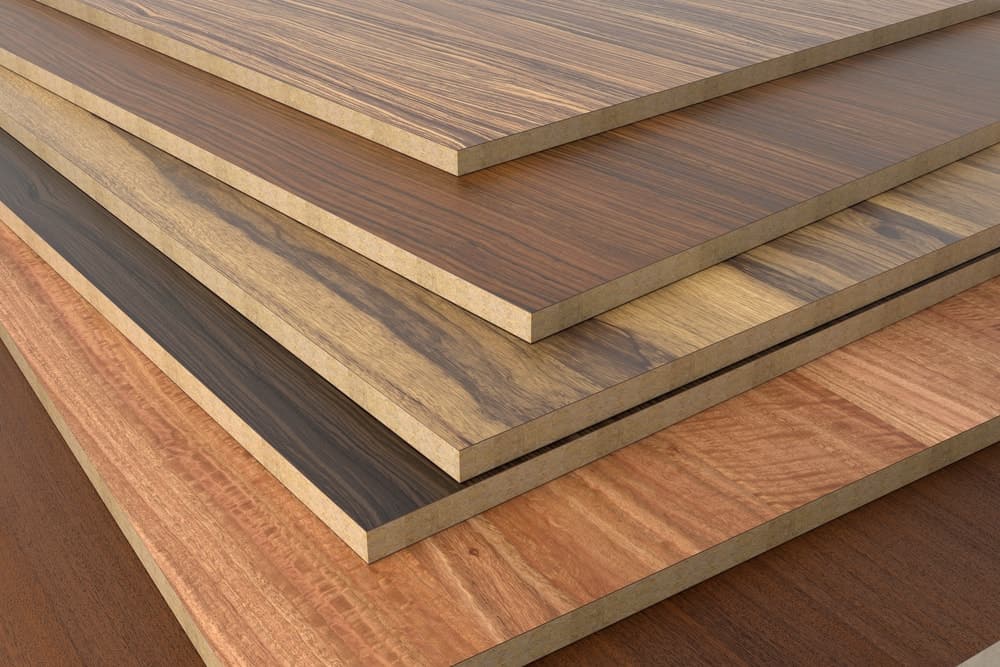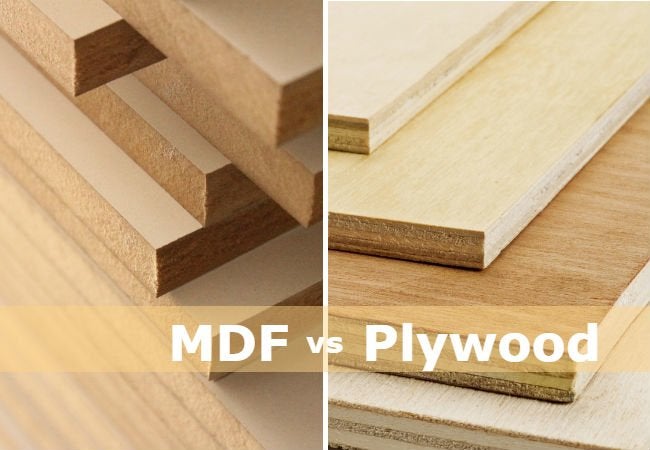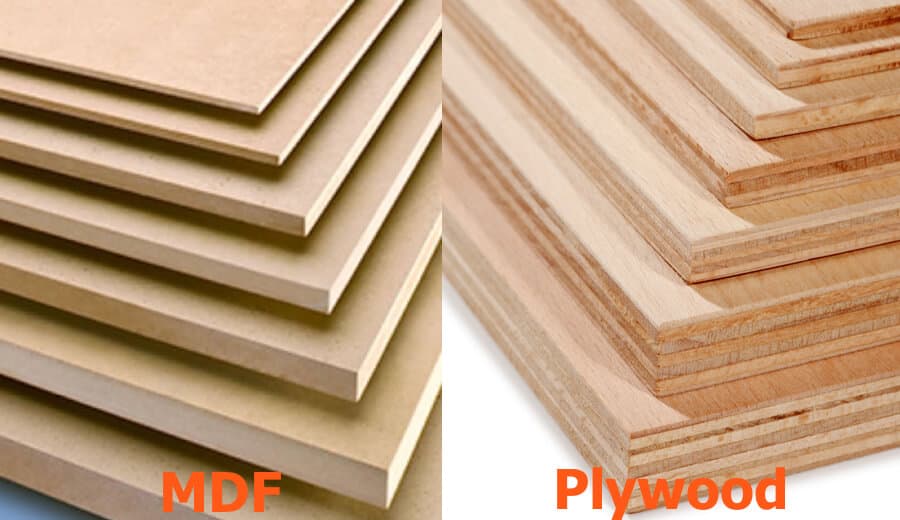Some woodworkers, usually beginners, make a mistake of thinking that MDF and plywood are the same. While there are a number of similarities between the two materials, there are also some significant differences that will make you reconsider choosing one over the other for your next project. MDF vs plywood – which one is better? Let us take a look.
MDF – What it Is

MDF, or medium density fiberboard is an engineered wood that comes from softwood composites. It is made out of small fibers from wood that are joined together with was, producing panels and applying high temperature or pressure.
During the manufacturing process, wood is broken down into basic fiber lumps. As such, there is no need to consider the wood’s specific species, knottiness, straightness, and other factors. This makes it possible for manufacturers to get cheaper options for the raw materials, thus keeping the actual costs low.
The fibers are combined using an adhesive, pressing them together with heat. The heat plays the role in curing the adhesive, making the fibers more pliable during the process of pressing. MDF is available in different grades and thicknesses. MDF is commonly used in making furniture, shelves, cabinets, storage fixtures, and other wall cladding decorations.
MDF Characteristics
- Lighter than plywood
- Ideal substrate for veneer
- Smooth, consistent and knot-free surface
- Absorbs some types of paints such as spray primers
- Ideal for primers that uses oil as base
- The resistance impact of MDF is significantly lower than plywood
Pros
- Cheaper than plywood
- Very consistent, making edges appear nice and smooth, without splinters
- MDF surface is smooth, making it ideal for painting
- A router may be used in creating decorations on the MDF’s smooth edges
- The smoothness and consistency of MDF makes it suited for detailed design cuts
Cons
- Just like a regular particle board, MDF can soak up water unless sealed accordingly
- It does not have the capacity to hold screws quite well
- It contains VOCs so there is a need to take good care of it while sanding and cutting
- It cannot be stained because it does not soak up the stain
- Because of its density, it is quite heavy, making it challenging to work with
Plywood – What It Is

Like MDF, plywood is an engineered product using wood. It is achieved by binding and pressing together wood veneer sheets into a single solid piece. It also comes in various thicknesses, as well as grades, allowing you to select the best one that will fit the needs of your project.
Typically, the lower grade ones are suited for home construction. The higher grades, on the other hand, are much smoother and prettier. They are the ones that are cabinet and stain grade. Unlike MDF, plywood feature a consistent wood grain while lacking knot holes and other forms of imperfections. Since there are also some veneered plywood from different species of wood, you can also choose the best one that will help you achieve the looks that you are looking for your final project.
Plywood Characteristics
- Durable type of building material, with the grain on every veneer layer running across varying directions
- Quite resistant to water damage
- Looks similar to that of a real wood with a good wooden appearance
- Heavier in size than MDF
- Will not swell easily or soak up water
- Has the capacity to hold screws quite tightly
- Cutting exposes to splinters and sharp edges
- Quite challenging to cut for creating intricate design details
Pros
- It is manufactured using several wood veneers layers, making it a very strong material to deal with
- It does not soak up liquids and water as MDF making it less prone to water damage
- Since it has grain, it is stainable, making it ideal for making furniture like kitchen cabinets and tabletops where you need a huge surface for staining
- It can hold screws quite well, and tightly, thanks to the different wood grains on every layer which gives the screws a place to hold on to.
Cons
- Relatively more expensive than MDF, with the price getting higher depending on the wood species
- Requires finishing using iron on edge banding decorative moldings or timber pieces
- Its challenging to achieve a smooth cut using plywood
- More challenging to achieve detailed cut designs since the edges tend to splinter
MDF vs Plywood – Their Uses

When it comes to making a comparison between the two types of materials, knowing about the characteristics of each will help you make a good decision. For example, since MDF cannot handle moisture quite well, it is suited for decorative purposes and indoor applications, such as the making of furniture.
MDF is also well suited for output that requires specific cutting, shaping and drilling because it does not easily splinter like plywood. If you are planning to use paint, then MDF is the ideal choice in order to achieve a smooth overall effect.
On the other hand, for constructions of floors, stairs, doors and other outdoor projects, it is recommended to use plywood. This material has the capacity to hold well to water exposure. It is also able to handle heavy loads, which make them idea for framing kitchen cabinets and walls.
If budget is your main factor in deciding, then MDF is the obvious choice. Still, if strength and durability is what you are looking for, then plywood wins the game.
Conclusion
MDF vs plywood – which one is best for your next project? The information above will help you make the best possible decision. Since MDF is not capable of handling moisture quite well, it is more suitable for use indoors, such as when making furniture. At the same time, it features a non-directional structure for the grains, making them suited for cutting, drilling and machining without dealing with chipping or splinters. Its smooth surface is good for creating basic interior design items that needs to be painted. On the other hand, plywood is more stable, making them suited for use on stairs, doors, floors and exterior projects. Since they also bend with the grain quite easily, they are also used in creating curved surfaces.

Leave a Reply